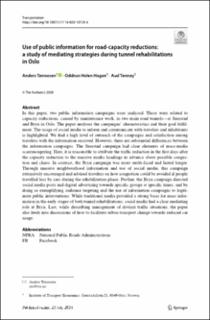| dc.contributor.author | Tønnesen, Anders | |
| dc.contributor.author | Hagen, Oddrun Helen | |
| dc.contributor.author | Tennøy, Aud | |
| dc.coverage.spatial | Oslo, Norway | en_US |
| dc.date.accessioned | 2021-08-02T10:24:00Z | |
| dc.date.available | 2021-08-02T10:24:00Z | |
| dc.date.created | 2020-08-03T20:18:51Z | |
| dc.date.issued | 2020-07-22 | |
| dc.identifier.citation | Transportation. 2020, 1-24. | en_US |
| dc.identifier.issn | 0049-4488 | |
| dc.identifier.uri | https://hdl.handle.net/11250/2765812 | |
| dc.description.abstract | In this paper, two public information campaigns were analysed. These were related to capacity reductions, caused by maintenance work, in two main road tunnels—at Smestad and Bryn in Oslo. The paper analyses the campaigns’ characteristics and their goal fulfilment. The usage of social media to inform and communicate with travelers and inhabitants is highlighted. We find a high level of outreach of the campaigns and satisfaction among travelers with the information received. However, there are substantial differences between the information campaigns. The Smestad campaign had clear elements of mass-media scaremongering. Here, it is reasonable to attribute the traffic reduction in the first days after the capacity reduction to the massive media headings in advance about possible congestion and chaos. In contrast, the Bryn campaign was more multi-faced and lasted longer. Through massive neighbourhood information and use of social media, this campaign extensively encouraged and advised travelers on how congestion could be avoided if people travelled less by cars during the rehabilitation phase. Further, the Bryn campaign directed social media posts and digital advertising towards specific groups at specific times, and by doing so exemplifying audience targeting and the use of information campaigns to legitimate public interventions. While traditional media provided a strong basis for mass information in the early stages of both tunnel rehabilitations, social media had a clear mediating role at Bryn. Last, while describing management of deviant traffic situations, the paper also feeds into discussions of how to facilitate urban-transport change towards reduced car usage. | en_US |
| dc.language.iso | eng | en_US |
| dc.publisher | Springer | en_US |
| dc.rights | Navngivelse 4.0 Internasjonal | * |
| dc.rights.uri | http://creativecommons.org/licenses/by/4.0/deed.no | * |
| dc.title | Use of public information for road-capacity reductions: a study of mediating strategies during tunnel rehabilitations in Oslo | en_US |
| dc.type | Peer reviewed | en_US |
| dc.type | Journal article | en_US |
| dc.rights.holder | © The Author(s) 2020 | en_US |
| dc.description.version | publishedVersion | en_US |
| cristin.ispublished | true | |
| cristin.fulltext | postprint | |
| cristin.qualitycode | 1 | |
| dc.identifier.doi | 10.1007/s11116-020-10128-6 | |
| dc.identifier.cristin | 1821444 | |
| dc.source.journal | Transportation | en_US |
| dc.source.pagenumber | 1-24 | en_US |
| dc.relation.project | Norges forskningsråd: 257152 | en_US |

